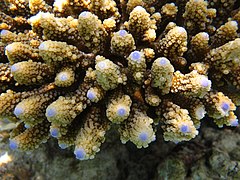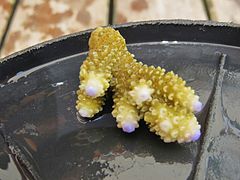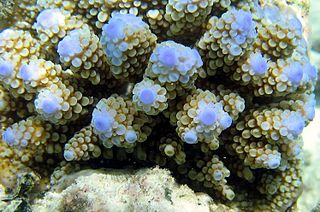
Acropora nasuta is a species of branching stony coral in the family Acroporidae. It is native to the western and central Indo-Pacific where it is found in shallow reef habitats. Like other corals of the genus Acropora, it is susceptible to coral bleaching and coral diseases and the IUCN has listed it as being "Near Threatened".

Acropora abrotanoides is a species of acroporid coral found in Indo-Pacific waters from the Red Sea and the Gulf of Aden east to the East China Sea, Japan, the central Pacific Ocean and Australia. It is found in shallow coral reefs that are exposed to the action of strong waves, at depths up to 15 m. It is vulnerable to coral bleaching, disease and crown-of-thorns starfish. It is resistant to predation as it has well-developed radial corallite lips.
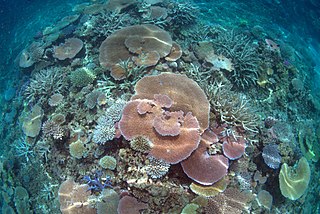
Acropora hyacinthus is a species of Acropora described from a specimen collected in Fiji by James Dwight Dana in 1846. It is thought to have a range that includes the Indian Ocean, the Indo-Pacific waters, southeast Asia, Japan, the East China Sea and the western Pacific Ocean. It lives on shallow reefs on upper reef slopes, and is found from depths of 1–25 metres (3.3–82.0 ft). Crown-of-thorns starfish preferentially prey upon Acropora corals.

Acropora cerealis is a species of acroporid coral found throughout the Indian and Pacific oceans, from the Red Sea and the Gulf of Aden to the Hawaiian Islands and the Johnston Atoll. It can be found on upper reef slopes in shallow tropical reefs, from depths of 3–20 m. Crown-of-thorns starfish preferentially prey upon Acropora corals, and this species is also harvested for the aquarium trade.

Acropora muricata, commonly called staghorn coral, is a species of acroporid coral found in the Gulf of Aden, the Red Sea, Indian Ocean, Persian Gulf, Australia, central Indo-Pacific, Japan, Southeast Asia, the East China Sea and the oceanic central and western Pacific Ocean. It is found in tropical shallow reefs, slopes of reefs, and in lagoons, from depths of 5 to 30 m. It was described by Dana in 1846.

Acropora gemmifera is a species of acroporid coral found in the Gulf of Aden, the Red Sea, the central Indo-Pacific, the southwest and northern Indian Ocean, southeastern Asia, Australia, the East China Sea, Japan, the oceanic central and western Pacific Ocean, and northwestern Hawaiʻi. It occurs on exposed upper reef flats and slopes, from depths of 1–15 m. It was described by Brook in 1892.

Acropora globiceps is a species of acroporid coral found in the oceanic central and western Pacific Ocean and central Indo-Pacific. It can also be found in the Great Barrier Reef, the Philippines, the Andaman Islands, Polynesia, Micronesia and the Pitcairn Islands. It occurs on the slopes of reefs, the flats of reefs, in tropical shallow reefs, and at depths of around 8 metres (26 ft). It was described by Dana in 1846.

Acropora listeri is a species of acroporid coral found in the Gulf of Aden, the Red Sea, the northern Indian Ocean, Australia, the central Indo-Pacific, Japan, southeast Asia, the East China Sea and the central and western Pacific Ocean. It is also present in Mauritius. The species is found in tropical shallow reefs on their upper slopes, especially in locations exposed to the action of strong waves, at depths of between 3 and 15 metres. It was described by Brook in 1893.

Acropora monticulosa is a species of acroporid coral found in the southwest and northern Indian Ocean, the central Indo-Pacific, Australia, Southeast Asia, Japan, the East China Sea and the oceanic west Pacific Ocean. It is also found in the Tuamotus. It occurs in tropical shallow reefs on upper slopes, from depths of 1 to 12 metres. It was described by Brüggemann in 1879.
Acropora speciosa is a species of acroporid coral found in the Red Sea, the Gulf of Aden, the southwest and northern Indian Ocean, the central Indo-Pacific, Southeast Asia, Japan, the East China Sea, eastern Australia and the oceanic west and central Pacific Ocean. It occurs in shallow reefs at depths of 2 to 25 metres.

Acropora robusta is a species of acroporid coral found in the Red Sea, the Gulf of Aden, the southwest and northern Indian Ocean, the central Indo-Pacific, Australia, Southeast Asia, Japan, the East China Sea and the oceanic west and central Pacific Ocean. It occurs in tropical shallow reefs, mainly along margins that are exposed to the action of strong waves, and can be found at depths from 1 to 8 metres. It was described by Dana in 1846.

Acropora samoensis is a species of acroporid coral found in the Red Sea, the Gulf of Aden, the southwest and northern Indian Ocean, the central Indo-Pacific, Australia, Southeast Asia, Japan, the East China Sea and the oceanic west and central Pacific Ocean. It occurs in tropical shallow reefs on upper slopes of reefs, from depths of 5 to 15 metres. It was described by Brook in 1891.
Acropora subglabra is a species of acroporid coral found in the northern Indian Ocean, the central Indo-Pacific, Australia, Southeast Asia, Japan, the East China Sea and the oceanic west Pacific Ocean. It occurs in tropical shallow reefs, and its range is often restricted to sheltered back reefs containing soft substrates and clear water. It can be found from depths of 5 to 15 metres and was described by Brook in 1891.

Acropora tenuis is a species of acroporid coral found in the Red Sea, the Gulf of Aden, the southwest, northwest and northern Indian Ocean, the Persian Gulf, the central Indo-Pacific, Australia, Southeast Asia, Japan, the East China Sea and the oceanic west and central Pacific Ocean. It occurs in tropical shallow reefs on upper slopes and in subtidal habitats, at depths of 8 to 20 metres.

Acropora valida is a species of acroporid coral found in the Red Sea, the Gulf of Aden, the southwestern, northwestern and northern Indian Ocean, the Persian Gulf, the central Indo-Pacific, Australia, southeast Asia, Japan, the East China Sea, the oceanic western, central and far eastern Pacific Ocean, the northwestern Hawaiian Islands and Johnston Atoll. It occurs in tropical shallow reefs in a variety of reef habitats, at depths of 1 to 15 metres.

Acropora humilis, also known as finger coral, is a species of acroporid coral found in the Gulf of Aden, the Red Sea, the northern and southwestern Indian Ocean, Australia, the central Indo-Pacific, Japan, southeast Asia, the East China Sea, the central and western Pacific Ocean, the Johnston Atoll and the northwestern Hawaiian Islands. It also occurs in the Raja Ampat Islands, Mariana Islands, Palau, and the Pitcairn Islands. Occurring in tropical shallow reefs on upper reef flats and slopes at depths of up to 12 metres (39 ft), it was described by Dana in 1846.
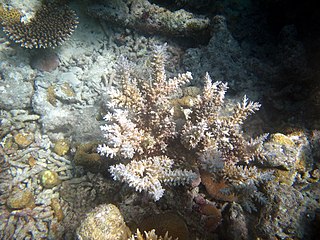
Acropora echinata is a species of acroporid coral that was first described by Dana in 1846. Found in shallow, tropical, sheltered reefs in marine environments, it is found at depths of 8 to 25 m in clear water. The species is listed as vulnerable on the IUCN Red List, and has a decreasing population. It is not common but found over a large area, and is listed under CITES Appendix II.

Acropora horrida is a species of acroporid coral that was first described by James Dwight Dana in 1846. Found in tropical, shallow reefs in marine environments, it occurs near fringing reefs around turbid water, at depths of 5 to 20 m. It is listed as a vulnerable species on the IUCN Red List, and it is thought to have a decreasing population. It is not common and found over a large area, and is listed under CITES Appendix II.

Acropora microclados is a species of acroporid coral that was first described by Christian Gottfried Ehrenberg in 1834. Found in marine, tropical shallow reefs on the upper slopes, it is found at depths of 5 to 20 m. It is listed as a vulnerable species on the IUCN Red List, and its population is decreasing. It is uncommon but found over a large area, including in five regions of Indonesia, and is classified under CITES Appendix II.

Acropora polystoma is a species of acroporid coral that was first described by G. Brook in 1891. Found in marine, tropical, reefs on upper slopes where waves are strong, it occurs at depths between 3 and 10 m. It is classed as a vulnerable species on the IUCN Red List, and it has a decreasing population. It is not common and found over a large area and is classified under CITES Appendix II.



